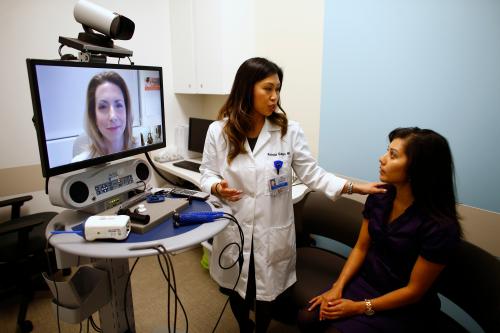Since 2018, I’ve been administering an economic pilot to help marginalized groups find high-tech careers. Soon after I began, it became clear that mental health challenges were a critical factor for the participants. For instance, we had two single mothers in the program who were aspiring computer programmers in Silicon Valley. One ended up with a high-paying job at a household name company while the other struggled to get her first internship. When I investigated the difference between the two, I learned that the successful participant had been getting subsidized mental health care, which she skillfully cobbled together from disparate local resources available for single mothers.
“On my way into tech, mental health services impacted how I would learn and soak in the information needed to do my current job…with the intensity of the stress that came with doing a bootcamp while post-homeless, divorcing and juggling two small children, I began to experience episodes and sought medication to alleviate the symptoms,” the participant told me. “Advocating for myself and being open about my experience during bootcamp made things smoother and less weighted, compared to if I had navigated my stressors and accommodations alone.”
It was stories like these that convinced me to reprioritize our economic pilot to mental health innovation. Depression, anxiety and stress exacerbated by the pandemic were holding back our participants from breaking into the tech sector. While there was plenty of philanthropy flowing toward vocational training, I found that these well-funded training centers were still overburdened with mental health challenges. Students would come to administrators for help, but the school staff wasn’t equipped to offer resources.
So, I offered our partner schools financial assistance to any student looking for mental health services. From one school, I was told that each person we offered support to had either gotten a job or were in the process of getting an offer.
As explained by one student:
“My therapy sessions helped me to learn and understand more about myself and to handle my emotions and thoughts,” one told us, who had seen how the rough job market of the pandemic was taking a toll on his colleagues at school. “Speaking with some of my classmates the other day, I can tell that some of them are not handling rejection from employers very well, some of them feel discouraged and I believe therapy could help them with those emotions.”
Unfortunately, even subsidized mental health services proved insufficient for many participants, because of overburdensome occupational licensing, antiquated public health technology and the criminalization of lower-cost pharmaceuticals.
That is, I learned that we need innovation in mental health services to make it more accessible to marginalized groups.
After I decided to subsidize teletherapy resources to our participants, we quickly ran into problems. For instance, there’s a severe shortage in qualified counselors and this was in fact the case for at least one of our participants who couldn’t find a specialist in their state.
Frustrated by this issue, I signed up myself for a big teletherapy provider to see what was going on and, indeed, was told that there were no providers in their network in California for my particular issue.
Why? In part, occupational licensing regulations prevent some counselors from practicing across state lines, even remotely. This means that even if there’s a talented, experienced mental health professional in Oklahoma, they may not be allowed to service a patient in California without the proper license.
There have been policy efforts to increase interstate portability, but they were evidently insufficient for me and the pilot participants.
That wasn’t our only issue, however. New York has been better about COVID-19 emergency waivers for out-of-state therapists, but not all of our participants felt comfortable with fully remote therapy. Getting in-person services with a nonprofit therapist is a tricky maze. It took me weeks to try and even get an appointment with one of the providers suggested by NYC authorities. After multiple calls, I still didn’t get one on the books.
The non-profit mental health system felt decades behind teletherapy startups like BetterHelp, who we used for remote counseling. The public health system didn’t even have email or an online calendaring system, let alone a sophisticated app that could book immediate appointments.
As I’ve written about before for Brookings, little bits of inertia end up being a significant barrier, especially for groups that are already saddled with all sorts of other problems. It’s hard for a single mother to have the mental bandwidth and schedule an appointment under these unnecessarily difficult systems.
Labor shortages are not the only challenge: pharmaceuticals are an important part of mental health treatment but can be prohibitively expensive. We have one participant who needs on-going financial support to afford her prescription.
Aside from direct financial support of expensive pharmaceuticals, there are regulatory advances in legalizing lower cost options, especially in what is conventionally called “psychedelics”.
One recent study found that 3,4-methylenedioxymethamphetamine (MDMA), more commonly known as “ecstasy”, was substantially less expensive for treating PTSD, and will likely soon be legally available after it clears the last leg of clinical trials for the Food and Drug Administration (FDA). Psychedelics are shown to treat mental health challenges in as little as a single therapy session, rather than years of on-going treatment. At the moment, these FDA trials require in-person therapy, so could these new pharmaceuticals be available remotely?
There is some evidence to suggest that psychedelic pharmaceuticals can be remotely administered. Ketamine, an antidepressant dissociative anesthetic with psychedelic properties, was recently made commercially available. The industry is still quite small, among the few early entrants into the space, I found one that seemed to have quickly adapted to the pandemic and moved almost entirely toward remote therapy.
“We now ship a “Bloombox” to each client’s home, which includes both medical (e.g. blood pressure cuff) and experiential (e.g. luxury eye mask, journal) items to facilitate a safe and seamless journey for our clients,” wrote Jack Swain, Head of Clinical Operations at Mindbloom, a venture-backed mental health startup that administers Ketamine therapy.
“Before COVID, FDA regulations required prescribers to conduct an in-person examination prior to treatment. This requirement has been waived during COVID, which allows us to provide treatment to those who need it while they remain safely in their homes.”
In addition to Ketamine, policy makers will need to grapple with the naturally occurring psychedelic, psilocybin, a compound found in “magic mushrooms” that was recently legalized through a ballot initiative in Oregon for mental health treatment.
The initiative statutorily requires the state to assemble an expert panel that will advise the Oregon health authority on licensing systems that will be commercially available in two years.
Psilocybin-assisted therapy, like ecstasy, shows promise as a lower cost mental health adjunct, but runs into all of the same problems as the rest of the mental health system.
Indeed, I’ve recently published a pre-print (not peer reviewed) analysis of psychedelics counseling of psilocybin under similar contexts as the remote Ketamine counseling. It suggests that under supervised contexts, virtual counseling could be safely offered under Oregon’s new law.
As policymakers consider options to improve access to mental health, there are a few models that may prove fruitful to explore through pilot projects and regulatory “sandboxes”, where private providers and public agencies can collaboratively test ideas with greater oversight. As I’ve written about before for Brookings, the benefit of pilots is that they can more quickly test out competing policy ideas at the same time.
Some states have addressed the undersupply of licensed counselors with “peer counselors”, which are certified mental health practitioners that provide adjunct therapy and be trained in just a few weeks.
To address safety concerns surrounding novel certifications and pharmaceuticals, there is some evidence to suggest that online rating systems can help consumers make informed decisions, even regarding public health. As consumers publically evaluate providers on popular websites, such as Yelp and Google, it might be worth studying if and how these ratings compare in safety and quality to more official ratings and licenses.
As teletherapy and psychedelics become more commonplace, they will inevitably be utilized for diagnoses and problems different than those in more tightly controlled experiments. There is growing bipartisan support for utilizing “real world evidence” from electronic medical records and online forums as an alternative to small experimental studies, since observational evidence is both much quicker and can apply to populations often left out of experimental research (such as those who are pregnant). The feasibility of observational data is dependent on providers collecting the right kind of information, otherwise it is quite limited in how it compares to more traditional trials. Public leaders can draft data collection standards that best promote the advancement of science.
Federally, lawmakers could either support mental health innovation directly or through states, such as Oregon, that have taken initiative to begin piloting new models. So, for instance, lawmakers could choose to allow scientific funding for any new mental health intervention deemed a “breakthrough” treatment by a federal agency or give block grants to a state health agency to promote scientific inquiry of a novel therapy.
In conclusion, innovations and smart regulation, from virtual care to rapid certifications and lower-cost psychedelic pharmaceutical-assisted therapy, will help ensure treatment is accessible to marginalized groups. Some federal lawmakers have already rightly recognized scientific innovation in energy, biology and artificial intelligence as an important driver of equity. An inclusive economic recovery will also need to address the crisis in mental health, and improving mental health will require a commitment to innovation.
The Brookings Institution is committed to quality, independence, and impact.
We are supported by a diverse array of funders. In line with our values and policies, each Brookings publication represents the sole views of its author(s).











Commentary
Mental health innovation is important for economic recovery and upward mobility
January 8, 2021